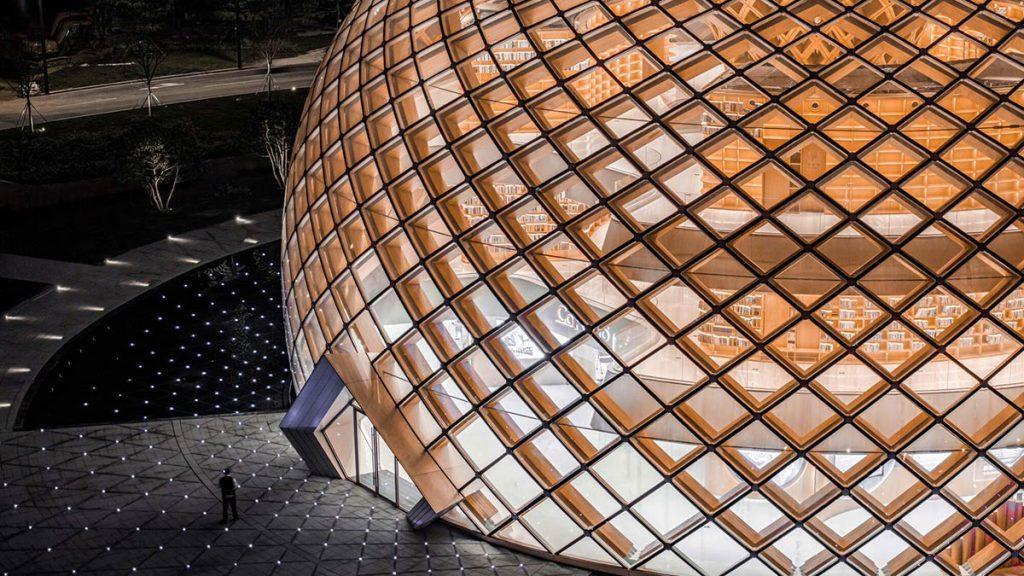China’s commitment to nanotechnology research is demonstrated by the newly opened Exhibition Center of CANNANO. Housed within a striking wooden dome, this spherical structure gives cutting-edge science a stage where high-tech aesthetics take center stage.
According to experts, few fields hold more disruptive potential than nanotechnology. This discipline deals with structures on the scale of nanometers—one billionth of a meter—essentially the size of atoms and molecules. Nanotechnology seeks to harness the unique physical, chemical, and biological properties materials exhibit at this scale. Already found in everyday items like sunscreens, non-stick pans, and smartphone batteries, nanotech is a rapidly advancing frontier. China has heavily invested in nanoscience, establishing specialized research centers. To give visibility to breakthroughs in this field, the Exhibition Center of CANNANO was constructed in Guangzhou, the third-largest city in the country.

The Exhibition Center’s wooden dome, based on the Zollinger construction system, spans 39 meters in diameter and reaches 21 meters in height, offering around 4,160 square meters of usable space. Within this concentrically arranged innovation park for nanotechnology, the transparent sphere acts as a cosmic focal point—a nano-planet dedicated to the tiniest building blocks of matter. Like a high-tech snow globe, it makes scientific achievements—usually confined to academic circles—accessible to the public.
The uppermost level is particularly impressive, offering a 360-degree panoramic view of the surrounding area. Events like exhibitions, scientific conferences, and press meetings are held throughout the various spaces.

Two Independent Structures, One Architectural Vision
The building comprises two independent systems: a dome-shaped glulam lattice shell and a steel load-bearing structure. The organic form of the timber lattice rises like a tree trunk from the building’s center, widening toward the top before sloping down again at the dome’s edge.
Inspired by the Giant Sequoia
The architects at HOT DESIGN were inspired by the giant sequoia, a tree known for forming root networks with neighboring trees to stabilize and support its massive height—sometimes up to 100 meters. Similarly, the wooden lattice structure embodies interconnectedness and mutual growth among disciplines, specialties, and teams striving for academic excellence.


The geometric shape of the lattice, reminiscent of an apple core, is enclosed by a glass curtain façade that spans the entire structure. At night, the transparent dome becomes a glowing beacon, its surroundings evoking a scene from a science fiction film.

China’s First Hyperbolic Zollinger Timber Shell
According to the architects, this is China’s first glulam grid shell of its kind. The structure is based on a hyperbolic Zollinger framework, a construction method developed in early 20th-century Germany. Due to its material efficiency and space-saving design, the system is experiencing a resurgence.

High-Tech Aesthetics Meet Warm Timber
Inside, warm wood contrasts with curved metallic elements and reflective glass balustrades. The cantilevered levels, with anodized aluminum cladding and ultra-white glass, evoke technological progress.

A fully integrated building services system heightens the futuristic atmosphere: circular technical elements wrap around the core, housing lighting, air conditioning, and sprinklers under a sleek metal ceiling. The result is an interior reminiscent of the Starship Enterprise.
Outside, the building is surrounded by precisely aligned ground spotlights, marking the center of the CANNANO Park. With the completion of this dome, and the surrounding nanotech research buildings arranged in its orbit, the architectural constellation is now complete.
Text: Gertraud Gerst
Fotos: Juan Liu


iThere are no comments
Add yours